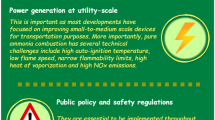Abstract
In this paper, we investigate the exergy analysis of the combustion chamber supplied by different fuel compositions based mainly on methane and/or hydrogen in order to select the optimum fuel composition case for the economic combustion. For this, the analysis process considers the variation for both parameters: mass flow rate and equivalence ratio. This is to characterize all fuel cases. The calculations are based on the prediction of three variables: the exergy destruction and the exergy universal efficiency, the contribution of exergy destruction sources and the effect of fuel composition on these sources. Therefore, all computations of this investigation are carried out by the Cycle-Tempo Release to determine the appropriate fuel composition. In the overall, the obtained results show that the hydrogen enrichment methane flame has an impact on the combustion efficiency.




Similar content being viewed by others
REFERENCES
Ilbas, M., Yılmaz, I., and Kaplan, Y., Int. J. Hydrogen Energy, 2005, vol. 30, no. 10, pp. 1139–1147. https://doi.org/10.1016/j.ijhydene.2004.10.016
Hu, E., Huang, Z., Zheng, J., Li, Q., and He, J., Int. J. Hydrogen Energy, 2009, vol. 34, no. 15, pp. 6545– 6557. https://doi.org/10.1016/j.ijhydene.2009.05.080
Khanafer, K., and Aithal, S.M., Int. J. Heat and Mass.Transfer, 2011, vol. 54, no. 23, pp. 5030–5038. https://doi.org/10.1016/j.ijheatmasstransfer.2011.07.017
Bouras, F., and Khaldi, F., Heat and Mass Transfer, 2016, vol. 52, no. 4, pp. 671–681.
Bingue, J.P., Saveliev, A.V., and Kennedy, L.A., Int. J. Hydrogen Energy, 2004, vol. 29, no. 13, pp. 1365–1370. https://doi.org/10.1016/j.ijhydene.2004.01.002
Bouras, F., and Khaldi, F., J. Appl Mechanics & Tech. Physics, 2016, vol. 57, no. 1, pp. 20–26.
Zhang, Y., Huang, Z., Wei, L., Zhang, J., and Lawb, C.K., Combust. & Flame, 2012, vol. 159, no. 3, pp. 918–931. https://doi.org/10.1016/j.combustflame.2011.09.010
Ayoub, M., Rottier, C., Carpentier, S., Villermaux, C.M., Boukhalfa, A., and Honore, D., Int. J. Hydrogen Energy, 2012, vol. 37, no. 8, pp. 6912–6921. https://doi.org/10.1016/j.ijhydene.2012.01.018
Akansu, S.O., Kahraman, N., and Çeper, B., Int. J. Hydrogen Energy, 2007, vol. 32, no. 17, pp. 4279–4284. https://doi.org/10.1016/j.ijhydene.2007.05.034
Alavandi, S.K., and Agrawal, A.K., Int. J. Hydrogen Energy, 2008, vol. 33, no. 4, pp. 1407–1415. https://doi.org/10.1016/j.ijhydene.2007.12.005
Demuynck, J., De Paepe, M., Huisseune, H., Sierens, R., Vancoillie, J., and Verhelst, S., Appl. Thermal Eng., 2011, vol. 31, no. 6, pp. 1220–1228. https://doi.org/10.1016/j.applthermaleng.2010.12.023
Tseng, C.J, Int. J. Hydrogen Energy, 2002, vol. 27, no. 6, pp. 699–707. https://doi.org/10.1016/S0360-3199(01)00173-2
Kim, H.S., Arghode, V.K., Linck, M.B., and Gupta, A.K., Int. J. Hydrogen Energy, 2009, vol. 34, no. 2, pp. 1054–1062. https://doi.org/10.1016/j.ijhydene.2008.10.034
Bouras, F., Attia, M.E., Khaldi, F., and Si-Ameur, M., Int. J. Hydrogen Energy, 2017, vol. 42, no. 30, pp. 8932– 8939. https://doi.org/10.1016/j.ijhydene.2016.11.146
Ameri, M., and Enadi, N., J. Power Technologies, 2012, vol. 92, no. 3, pp. 183–191. http://papers.itc.pw.edu.pl/index.php/JPT/article/view/331/504.
Bouras, F., Attia, M.E.H., and Khaldi, F. Envi Proces, 2015,vol. 2, pp. 233–242 https://doi.org/10.1007/s40710-015-0102-6
Yilmazoğlu, M.Z., and Amirabedin, E., J. Thermal Sci. & Technol., 2011, vol. 31, no. 2, pp. 41–50.
Mali Sanjay, D., and Mehta, N.S., Int. J. Adv. Eng. Res. & Studies, 2012, vol. 1, no. 3, pp. 245–247.
Owen, F.K., Spadaccini, L.J., and Bowman, C.T., Proc. Combust. Inst., 1976, vol. 16, no. 1, pp. 105–117.
ACKNOWLEDGMENTS
The authors thank the Directorate General for Scientific Research and Technological Development (PRFU_ N°. B00L02UN390120200003).
Author information
Authors and Affiliations
Corresponding author
Ethics declarations
The authors declare that they have no conflict of interest.
Rights and permissions
About this article
Cite this article
Bouras, F., Khaldi, F. Optimization of Combustion Efficiency Using a Fuel Composition Based on CH4 and/or H2. Russ J Appl Chem 93, 1954–1959 (2020). https://doi.org/10.1134/S1070427220120198
Received:
Revised:
Accepted:
Published:
Issue Date:
DOI: https://doi.org/10.1134/S1070427220120198




